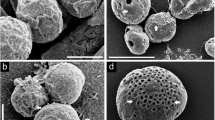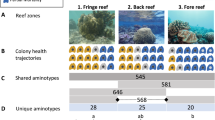Abstract
Transmission electron microscopy (TEM) was used to determine whether Acropora muricata coral colonies from the Great Barrier Reef (GBR), Australia, harboured virus-like particles (VLPs). VLPs were present in all coral colonies sampled at Heron Island (southern GBR) and in tagged coral colonies sampled in at least two of the three sampling periods at Lizard Island (northern GBR). VLPs were observed within gastrodermal and epidermal tissues, and on rarer occasions, within the mesoglea. These VLPs had similar morphologies to known prokaryotic and eukaryotic viruses in other systems. Icosahedral VLPs were observed most frequently, however, filamentous VLPs (FVLPs) and phage were also noted. There were no clear differences in VLP size, morphology or location within the tissues with respect to sample date, coral health status or site. The most common VLP morphotype exhibited icosahedral symmetry, 120–150 nm in diameter, with an electron-dense core and an electronlucent membrane. Larger VLPs of similar morphology were also common. VLPs occurred as single entities, in groups, or in dense clusters, either as free particles within coral tissues, or within membrane-bound vacuoles. VLPs were commonly observed within the perinuclear region, with mitochondria, golgi apparatus and crescent-shaped particles frequently observed within close proximity. The host(s) of these observed VLPs was not clear; however, the different sizes and morphologies of VLPs observed within A. muricata tissues suggest that viruses are infecting either the coral animal, zooxanthellae, intracellular bacteria and/or other coral-associated microbiota, or that the one host is susceptible to infection from more than one type of virus. These results add to the limited but emerging body of evidence that viruses represent another potentially important component of the coral holobiont.




Similar content being viewed by others
References
Ackermann HA (2001) Frequency of morphological phage descriptions in the year 2000. Arch Virol 146:843–857
Ainsworth TD, Fine M, Blackall LL, Hoegh-Guldberg O (2006) Fluorescence in situ hybridisation and spectral imaging of coral-associated bacterial communities. Appl Environ Microbiol 72:3016–3020
Anders K, Yoshimizu M (1994) Role of viruses in the induction of skin tumours and tumour-like proliferations of fish. Dis Aquat Org 19:215–232
Anderson IG, Shariff M, Nash G, Nash M (1987) Mortalities of juvenile shrimp, Penaeus monodon, associated with Penaeus monodon baculovirus, cytoplasmic reo-like virus, rickettsia and bacterial infections, from Malaysian brackish water ponds. Asian Fish Sci 1:47–64
Ben-Haim Y, Rosenberg E (2002) A novel Vibrio sp. pathogen of the coral Pocillopora damicornis. Mar Biol 141:47–55
Borsheim KY, Bratback G, Heldal M (1990) Enumeration and biomass estimation of planktonic bacteria and viruses by transmission electron microscopy. Appl Environ Microbiol 56:352–356
Breitbart M, Salamon P, Andresen B, Mahaffy JM, Segall AM, Mead D, Azam F, Rohwer F (2002) Genomic analysis of uncultured marine viral communities. Proc Natl Acad Sci USA 99:14250–14255
Brussaard CPD, Kempers RS, Kop AJ, Riegman R, Heldal M (1996) Virus-like particles in a summer bloom of Emiliania huxleyi in the North Sea. Aquat Microb Ecol 10:105–113
Brussaard CPD, Noordeloos AAM, Sandaa RA, Heldal M, Bratbak G (2004) Discovery of a dsRNA virus infecting the marine photosynthetic protist Micromonas pusilla. Virology 319:280–291
Cervino JM, Hayes R, Goreau TJ, Smith GS (2004) Zooxanthellae regulation in yellow blotch/band and other coral diseases contrasted with temperature related bleaching: in situ destruction vs expulsion. Symbiosis 37:63–85
Chen F, Suttle CA (1995) Amplification of DNA polymerase gene fragments from viruses infecting microalgae. Appl Environ Microbiol 61:1274–1278
Culley AI, Lang AS, Suttle CA (2003) High diversity of unknown picorna-like viruses in the sea. Nature 424:1054–1057
Cusack RB, Groman DB, MacKinnon A-M, Kibenge FSB, Wadowska D, Brown N (2001) Pathology associated with an aquareovirus in captive juvenile Atlantic halibut Hippoglossus hippoglossus and an experimental treatment strategy for a concurrent bacterial infection. Dis Aquat Org 44:7–16
Davy JE, Patten NL (2007) Morphological diversity of virus-like particles within the surface microlayer of scleractinian corals. Aquat Microb Ecol 47:37–44
Davy SK, Burchett SG, Dale AL, Davies P, Davy JE, Muncke C, Hoegh-Guldberg O, Wilson WH (2006) Viruses: agents of coral disease? Dis Aquat Org 69:101–110
Ducklow HW, Mitchell R (1979) Bacterial populations and adaptations in the mucus layers on living corals. Limnol Oceanogr 24:715–725
Elston R (1997) Special topic review: bivalve mollusc viruses. World J Microbiol Biotechnol 13:393–403
Essbauer S, Ahne W (2001) Viruses of lower invertebrates. J Vet Med Sci 48:403–475
Fuhrman JA (1999) Marine viruses and their biogeochemical effects. Nature 399:541–548
Guixa-Boixereu N, Lysnes K, Pedros-Alio C (1999) Viral lysis and bacterivory during a phytoplankton bloom in a coastal water microcosm. Appl Environ Microbiol 65:1949–1958
Haebler R, Moeller RB Jr (1993) Pathobiology of selected marine mammal diseases. In: Couch JA, Fournie JW (eds) Pathobiology of marine and estuarine organisms. CRC Press, Boca Raton, pp 217–244
Harrison PL (1990) Sperm morphology and fertilisation strategies in scleractinian corals, vol 5. In: Hoshi M, Yamashita O (eds) Advances in invertebrate reproduction, Elsevier Science Publishers, Amsterdam, pp 299–304
ICTV (2005) 8th Report of the international committee on taxonomy of viruses. Online access: http://www.ncbi.nlm.nih.gov/ICTVdb/index.htm
Jiang SC, Paul JH (1996) Occurrence of lysogenic bacteria in marine microbial communities as determined by prophage induction. Mar Ecol Prog Ser 142:27–38
Kaczmarsky LT (2006) Coral disease dynamics in the central Philippines. Dis Aquat Org 69:9–21
Kaczmarsky LT, Richardson LL (2007) Transmission of growth anomalies between Indo-Pacific Porites corals. Dis Aquat Org 94:218–221
Kazama FY, Schornstein KL (1972) Herpes-type virus particles associated with a fungus. Science 177:696–697
Kellogg CA (2004) Tropical archaea: diversity associated with the surface microlayer of corals. Mar Ecol Prog Ser 273:81–88
Kramarsky-Winter E, Harel M, Siboni N, Dov BE, Brickner I, Loya Y, Kushmaro A (2006) Identification of a protist-coral association and its possible ecological role. Mar Ecol Prog Ser 317:67–73
Lemke A, Nash CA (1974) Fungal viruses. Bacteriol Rev 38:29–56
Lesser MP, Mazel CH, Gorbunov MY, Falkowski PG (2004) Discovery of symbiotic nitrogen-fixing cyanobacteria in corals. Science 305:997–1000
Lightner DV, Redman RM (1998) Shrimp diseases and current diagnostic methods. Aquaculture 164:201–220
Lohr J, Munn C, Wilson WH (2007) Characterisation of a latent virus-like infection of symbiotic zooxanthellae. Appl Environ Microbiol 73:2976–2981
Loya Y, Bull G, Pichon M (1984) Tumour formations in scleractinian corals. Helgol Wiss Meeresunters 37:99–112
Moestrup O, Thomsen HA (1974) An ultrastructural study of the flagellate Pyramimonas orientalis with particular emphasis on golgi apparatus activity and the flagellar apparatus. Protoplasma 81:247–269
Moran NA, Degnan PH, Santos SR, Dunbar HE, Ochman H (2005) The players in a mutualistic symbiosis: Insects, bacteria, viruses, and virulence genes. Proc Natl Acad Sci USA 102:16919–16926
Nagasaki K, Tomaru Y, Shirai Y, Takao Y, Mizumoto H (2006) Dinoflagellate-infecting viruses. J Mar Biol Assoc UK 86:469–474
Nagasaki K, Tomaru Y, Nakanishi K, Hata N, Katanozaka N, Yamaguchi M (2004) Dynamics of Heterocapsa circularisquama (Dinophyceae) and its viruses in Ago Bay, Japan. Aquat Microb Ecol 34:219–226
Novoa RR, Calderita G, Arranz R, Fontana J, Granzow H, Risco C (2005) Viral factories: associations of cell organelles for viral replication and morphogenesis. Biol Cell 97:147–172
Panek FM (2005) Epizootics and disease of coral reef fish in the tropical Western Atlantic and Gulf of Mexico. Rev Fish Sci 13:1–21
Paul JH, DeFlaun MF, Jeffrey WH (1986) Elevated levels of microbial activity in the coral surface microlayer. Mar Ecol Prog Ser 33:29–40
Pienaar RN (1976) Virus-like particles in three species of phytoplankton from San Juan Island, Washington. Phycologia 15:185–190
Preisig HR, Hibberd DJ (1984) Virus-like particles and endophytic bacteria in Paraphysomonas and Chromophysomonas (Chrysophyceae). Nord J Bot 4:279–285
Proctor LM (1997) Advances in the study of marine viruses. Microsc Res Techniq 37:136–161
Ritchie KB (2006) Regulation of microbial populations by coral surface mucus and mucus-associated bacteria. Mar Ecol Prog Ser 322:1–14
Rohwer F, Edwards R (2002) The phage proteomic tree; a genome based taxonomy for phages. J Bacteriol 184:4529–4535
Rohwer F, Breitbart M, Jara J, Azam F, Knowlton N (2001) Diversity of bacteria associated with the Caribbean coral Montastraea franksi. Coral Reefs 20:85–91
Rohwer F, Seguritan V, Azam F, Knowlton N (2002) Diversity and distribution of coral-associated bacteria. Mar Ecol Prog Ser 243:1–10
Rowan R, Knowlton N (1995) Intraspecific diversity and ecological zonation in coral-algal symbioses. Proc Natl Acad Sci USA 92:2850–2853
Rungger D, Rastelli M, Braendle E, Malsberger RG (1971) A viruslike particle associated with lesions in the muscles of Octopus vulgaris. J Invertebr Pathol 17:72–80
Sano E, Carlson S, Wegley L, Rohwer F (2004) Movement of viruses between biomes. Appl Environ Microbiol 70:5842–5846
Schroeder DC, Oke J, Malin G, Wilson WH (2002) Coccolithovirus (Phycodnaviridae): characterisation of a new large dsDNA algal virus that infects Emiliania huxleyi. Arch Virol 2002:1685–1698
Sicko-Goad L, Walker G (1979) Viroplasm and large virus-like particles in the dinoflagellate Gymnodinium uberrimum. Protoplasma 99:203–210
Sutherland KP, Porter JW, Torres C (2004) Disease and immunity in Caribbean and Indo-Pacific zooxanthellae corals. Mar Ecol Prog Ser 266:273–302
Suttle CA (1994) The significance of viruses to mortality in aquatic microbial communities. Microb Ecol 28:237–243
Thingstad TF, Lignell R (1997) Theoretical models for the control of bacterial growth rate, abundance, diversity and carbon demand. Aquat Microb Ecol 13:19–27
Van Etten JL, Cane LC, Meints RH (1991) Viruses and viruslike particles of eukaryotic algae. Microbiol Rev 55:586–620
Wegley L, Edwards R, Rodriguez-Brito B, Lui H, Rohwer F (2007) Metagenomic analysis of the microbial community associated with the coral Porites astreoides. Environ Microbiol 9:2707–2719
Wegley L, Yu YN, Breitbart M, Casas V, Kline DI, Rohwer F (2004) Coral-associated archaea. Mar Ecol Prog Ser 273:89–96
Weil E, Smith G, Gil-Agudelo DL (2006) Status and progress in coral reef disease research. Dis Aquat Org 69:1–7
Weinbauer MG (2004) Ecology of prokaryotic viruses. FEMS Microbiol Rev 28:127–181
Weinbauer MG, Peduzzi P (1994) Frequency, size and distribution of bacteriophages in different marine bacterial morphotypes. Mar Ecol Prog Ser 108:11–20
Willis BL, Page CA, Dinsdale EA (2004) Coral diseases on the Great Barrier Reef. In: Rosenberg E, Loya Y (eds) Coral health and disease. Springer-Verlag, Berlin, pp 69–104
Wilson WH, Chapman DM (2001) Observation of virus-like particles in thin sections of the plumose anemone, Metridium senile. J Mar Biol Assoc UK 81:879–880
Wilson WH, Dale AL, Davy JE, Davy SK (2005) An enemy within? Observations of virus-like particles in reef corals. Coral Reefs 24:145–148
Wilson WH, Francis I, Ryan K, Davy SK (2001) Temperature induction of viruses in symbiotic dinoflagellates. Aquat Microb Ecol 25:99–102
Yamashiro H, Yamamoto M, Van Woesik R (2000) Tumour formation on the coral Montipora informis. Dis Aquat Org 14:211–217
Yarden O, Ainsworth TD, Roff G, Leggat W, Fine M, Hoegh-Guldberg O (2007) Increased prevalence of ubiquitous ascomycetes in an acroporid coral (Acropora formosa) exhibiting symptoms of brown band syndrome and skeletal eroding band disease. Appl Eviron Microbiol 73:2755–2757
Zhong Y, Chen F, Wilhelm SW, Poorvin L, Hodson RE (2002) Phylogenetic diversity of marine cyanophage isolates and natural virus communities as revealed by sequences of viral capsid assembly protein gene g20. Appl Environ Microbiol 68:1576–1584
Zillig W, Prangishvilli D, Schleper C, Elferink M, Holz I, Albers S, Janekovic D, Götz D (1996) Viruses, plasmids and other genetic elements of thermophillic and hyperthermophilic Archaea. FEMS Microbiol Rev 18:225–236
Acknowledgements
This research was supported by a Lizard Island Doctoral Fellowship, a NANOtap award and Southern Cross University postgraduate funding to N.L. Patten, Australian Research Council funding to J.G Mitchell and Southern Cross University funding to P.L. Harrison. The authors gratefully acknowledge the Centre of Microscopy and Microanalysis at the University of Queensland for assistance with electron microscopy. Special thanks to J. Davy, A. Carroll, R. Reef and C. Damiano for assistance in the field and to three anonymous reviewers for valuable comments on this manuscript.
Author information
Authors and Affiliations
Corresponding author
Additional information
Communicated by: Biology Editor Dr Michael Lesser.
Rights and permissions
About this article
Cite this article
Patten, N.L., Harrison, P.L. & Mitchell, J.G. Prevalence of virus-like particles within a staghorn scleractinian coral (Acropora muricata) from the Great Barrier Reef. Coral Reefs 27, 569–580 (2008). https://doi.org/10.1007/s00338-008-0356-9
Received:
Revised:
Accepted:
Published:
Issue Date:
DOI: https://doi.org/10.1007/s00338-008-0356-9




